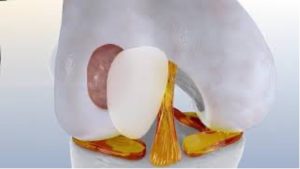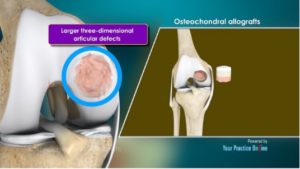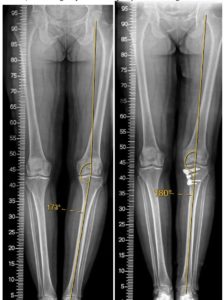Nearly 1 million patients undergo total knee replacement in the United States every year. For the right patient, total knee replacement can be a great option and allow patients a new lease on life. However, total knee replacement isn’t the answer for everyone. In fact, for every patient that undergoes a total knee replacement there are several others who are suffering from knee pain, but are in a seemingly “no man’s land.” These patients are generally 30-55 years old with knee pain related to cartilage damage. In the past these patients were often told, “You’re too young for a knee replacement and offered a steroid injection or a “clean up” knee scope to temporarily relieve their pain. Unfortunately, these patients often suffer for years; occasionally getting injections and trying all sorts of home remedies and over-the-counter medications in search of more permanent relief of their symptoms. Some are even sold on the false hope of a miracle cure of “stem cell injections” and often spend thousands of dollars to only end up back where they started; in pain and frustrated.
Fortunately, there are other options available which allow patients to keep their own knee and can help prolong or prevent ever needing a total knee replacement. These procedures are to treat the underlying cause of knee pain, not just mask the symptoms.
There are 3 main workhorse procedures that can be done for knee cartilage injuries —
1. MACI
2. OATs
3. OSTEOTOMY
–MOO!
1. “MACI” = Matrix-associated Autologous Chondrocyte Implantation. This is a surgical procedure in which a patient’s own cartilage cells are harvested, then grown in a lab, and implanted onto a cellularized scaffold which is then used to fill a cartilage defect. This is a great option for patients with medium to large sized cartilage defects
 .
.
2. “OATs” Osteochondral Allograft Transplantation. This is a surgical procedure in which a cylinder plug of donor cartilage and bone is implanted into the patient’s cartilage defect. This is also a great option for larger cartilage defects, and can also be used to address the underlying bone which can also be damaged.

3. Osteotomies are surgical procedures in which the bone is cut, shifting weight off the damaged side of the joint. An osteotomy can help relieve pain and significantly improve function in a damaged knee. Osteotomies are often used in combination with cartilage restoration procedures to increase the longevity of the newly implanted cartilage.


Quite insightful post. Never believed that it was this simple after all. I had spent a beneficial deal of my time looking for someone to explain this topic clearly and you’re the only 1 that ever did that. Kudos to you! Keep it up
Glad you found our post helpful!
Will you ever use Robot assisted total knee replacement? The results seem to encourage a better result by exact measure down to the Millimeter. In Addition, the Navio encourages doctors to put the knee through range of motion exercises for exact simulation of a specific patient’s knee. movement. I don’t know if it’s hype or not, but I want the best athletic outcome .
At this point, most of the studies have not shown any long term clinical benefits to robotic knee replacements. There is something to be said about having an experienced surgeon look and feel to ensure proper alignment and movement and not relying on robotics. Some studies show superior alignment but there’s also the added cost and added risk of fracturing through the drill pin sites which are required for all the navigation systems at this point. However, it is something we are monitoring closely and may add to our practice in the future.